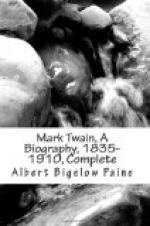He wrote one short tale, “The Canvasser’s Story,” a burlesque of no special distinction, and he projected for the Atlantic a scheme of “blindfold novelettes,” a series of stories to be written by well-known authors and others, each to be constructed on the same plot. One can easily imagine Clemens’s enthusiasm over a banal project like that; his impulses were always rainbow-hued, whether valuable or not; but it is curious that Howells should welcome and even encourage an enterprise so far removed from all the traditions of art. It fell to pieces, at last, of inherent misconstruction. The title was to be, “A Murder and a Marriage.” Clemens could not arrive at a logical climax that did not bring the marriage and the hanging on the same day.
The Atlantic started its “Contributors’ Club,” and Howells wrote to Clemens for a paragraph or more of personal opinion on any subject, assuring him that he could “spit his spite” out at somebody or something as if it were a passage from a letter. That was a fairly large permission to give Mark Twain. The paragraph he sent was the sort of thing he would write with glee, and hug himself over in the thought of Howells’s necessity of rejecting it. In the accompanying note he said:
Say, Boss, do you want this to lighten up your old freight-train with? I suppose you won’t, but then it won’t take long to say, so.
He was always sending impossible offerings to the magazines; innocently enough sometimes, but often out of pure mischievousness. Yet they were constantly after him, for they knew they were likely to get a first-water gem. Mary Mopes Dodge, of St. Nicholas, wrote time and again, and finally said:
“I know a man who was persecuted by an editor till he went distracted.”
In his reading that year at the farm he gave more than customary attention to one of his favorite books, Pepys’ Diary, that captivating old record which no one can follow continuously without catching the infection of its manner and the desire of imitation. He had been reading diligently one day, when he determined to try his hand on an imaginary record of conversation and court manners of a bygone day, written in the phrase of the period. The result was Fireside Conversation in the Time of Queen Elizabeth, or, as he later called it, 1601. The “conversation,” recorded by a supposed Pepys of that period, was written with all the outspoken coarseness and nakedness of that rank day, when fireside sociabilities were limited only by the range of loosened fancy, vocabulary, and physical performance, and not by any bounds of convention. Howells has spoken of Mark Twain’s “Elizabethan breadth of parlance,” and how he, Howells, was always hiding away in discreet holes and corners the letters in which Clemens had “loosed his bold fancy to stoop on rank suggestion.” “I could not bear to burn them,” he declares, “and I could not, after the first reading, quite bear to look at them.”




